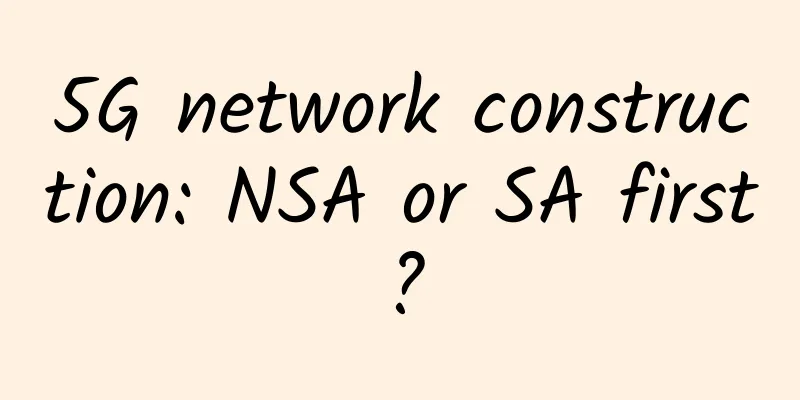5G network construction: NSA or SA first?

|
Different from the era from 3G to 4G, the evolution from 4G to 5G is no longer an “integrated” evolution of the core network and the wireless access network, but rather a “separation” of the two, including two deployment modes: NSA (non-standalone networking) and SA (standalone networking). As a result, the entire industry seems to be caught in a "difficulty in making a choice" situation. Whether to build the network first with NSA or SA has become a key issue. What is NSA? What is SA? What is the difference between NSA and SA? Should operators choose NSA or SA?
What is the difference between NSA and SA? They are both 5G, just different stages and strategies 1. Standards From the perspective of 3GPP 5G standards, NSA and SA are two different stages of the 5G R15 standard: the NSA standard was frozen in December 2017, the SA standard was frozen in June 2018, and a supplementary Late Drop was also frozen in March this year. In the design of mobile communication standards, there is a basic principle, which is forward compatibility, that is, the standard design needs to protect the initial investment and support the innovation of future networks. The first phase of the 5G standard, the NSA phase, basically realizes all the new features and capabilities of 5G, but at the same time, it also naturally supports the continuous evolution to SA in the future in the standard design, including future new features and new requirements, such as providing complete high-reliability connection capabilities, as well as the basic capabilities of V-2X and industrial Internet of Things, so that the introduction of these services does not require repeated network construction investment. In short, the currently frozen 5G standards provide operators with two options: NSA and SA, both of which are designed to build 5G faster, better and smoother, but the question that follows is: which one to choose? 2. Architecture The main difference between NSA and SA networking is that NSA anchors 5G control signaling on 4G base stations; the SA solution is that 5G base stations directly access the 5G core network, and control signaling is completely independent of the 4G network. In the early stage of 5G deployment, most operators started by investing in 5G base stations. In the future, no matter when operators choose to upgrade from 4G core network to 5G core network, the investment of operators in 5G base station hardware will remain unchanged. In fact, the 5G base stations provided by powerful equipment manufacturers are dual-mode, supporting both NSA and SA. In the future, base stations can achieve the evolution from NSA to SA only through software upgrades. 3. Experience and Application As early as 2015, the ITU (International Telecommunication Union) gave a clear definition of 5G: the main business scenarios of 5G include eMBB (enhanced mobile broadband), uRLLC (ultra-reliable and low-latency communication) and mMTC (massive machine type communication). The corresponding 5G technical indicators include: 1-20Gbps peak, 10-100Mbps user experience rate, 1-10 milliseconds end-to-end latency, 1-100 times improvement in network energy efficiency and 1 million connections per square kilometer. In terms of applications, NSA mainly provides high-bandwidth and low-latency services in the early stage, that is, it mainly targets the two major 5G scenarios of eMBB and uRLLC. The purpose is to gradually expand new applications and business models based on the mature 4G MBB ecosystem, such as expanding to eMBB services such as high-definition video, cloud games, AR/VR, and expanding to eMBB+uRLLC services such as smart manufacturing, remote control of special vehicles, and telemedicine, to help operators quickly achieve commercial success. In terms of experience requirements, in 2019, global 5G commercial deployment started. From the pre-commercial and commercial network tests of multiple operators, it can be found that the cell capacity peak of the network deployed by NSA can reach 14Gbps, the average rate of a single user can reach 2.5Gbps, and the end-to-end delay is within 1 millisecond. The energy efficiency of 5G is improved by 20-30 times compared with 4G, which meets the ITU definition of 5G. With the evolution of NSA to SA network, 5G SA network will further solve the scenarios where the industry has more stringent requirements for wireless technology, such as ultra-low latency scenarios such as autonomous driving and industrial control. At the same time, slicing of 5G SA network, as a unique function and technical means, will ensure special scenarios such as business isolation and QoS guarantee in special industries such as electricity and public security. In short, from the perspective of standard setting, architecture, experience and application, NSA and SA belong to the same 5G, but are at different stages of 5G. Therefore, choosing NSA or SA is not a question of "choose one or the other", but a question of "choose first or last". And this choice obviously needs to be analyzed in combination with specific circumstances. Operator's choice: NSA or SA first? Since the choice is difficult, let’s first look at the options of those operators who have suffered a lot and finally made a decision. In April 2019, South Korea was the first to commercialize 5G on a large scale, and the three major operators in South Korea chose NSA as their networking method. To be more precise, it was NSA first and then SA. For example, SKT’s latest public network evolution route - NSA was chosen for the initial 5G deployment, and the "NSA+SA" architecture will be adopted in the later stage. Image source: SK telecom In April 2019, Verizon in the United States also commercialized 5G almost at the same time as Korean operators, and it also chose NSA as its networking method. The speech of Verizon's CEO at the commercial launch conference was quite interesting. He said that the evolution from 4G to 5G is different from the evolution from 3G to 4G. The biggest difference is that there is dual connection between 4G and 5G, but there is no dual connection between 3G and 4G. Without "dual connection", there is no seamless "switch" between 3G and 4G. For example, if you are watching a video stream on the 4G network and the 4G connection is suddenly interrupted, it means that your video will also be interrupted. You need to wait for the phone to re-register with the 3G network before you can continue to watch the video on the 3G network. But in the 5G era, since 4G and 5G can be seamlessly "switched", it is equivalent to having double protection for the connection, which can achieve higher reliability. British operator EE officially launched 5G commercial services on May 30, and NSA was still the choice for early deployment. EE's NSA networking is even more interesting. As shown in the figure below, its 5G evolution is divided into three steps. The first phase (2019) adopts NSA deployment, and the second phase (2022) introduces the 5G core network. In other words, EE plans to achieve SA independent deployment by 2022 and network slicing after 2023. Image source: EE The plan surprised the industry and raised questions about whether the British operator was being too conservative. Although Japan's 5G has not yet been commercialized, they plan to launch 5G networks in the spring of 2020. However, Japanese operators have already determined the networking method. NTT DoCoMo and KDDI have stated that they will adopt NSA networking in the early stages of deployment to build 5G networks efficiently and economically; another new Japanese operator, Rakuten Mobile, has chosen SA networking. Image source: NTT DoCoMo In general, most operators around the world have chosen to deploy 5G from NSA, and very few operators have chosen to adopt SA from the beginning. What are the reasons and motivations behind these choices? Why NSA? Why SA? Why is NSA deployed first? Why is SA deployed first? The explanations given by Japan's two major operators, NTT DoCoMo and Rakuten Mobile, are very typical. The reason why Japan's Rakuten Mobile directly chose SA is simple. Their explanation is that because Rakuten Mobile is a new operator with almost no 4G assets and no need to protect 4G investment, it decided to build an end-to-end 5G network from the beginning. This is equivalent to drawing on a blank sheet of paper, and of course it can choose a more direct way to participate in the competition. But it is worth mentioning that the operator's plan to "build the world's first end-to-end fully virtualized 5G network" is considered by the industry to be an extremely adventurous move, a bit like "a newborn calf is not afraid of a tiger" and "the barefoot are not afraid of those wearing shoes". The old-fashioned operators with heavy assets will never easily imitate it. NTT DoCoMo, Japan's largest operator, would never do this. Not long ago, NTT DoCoMo's Chief Technology Officer Seizo Onoe explained at an industry summit why NSA was chosen for initial deployment, and the summary was very brilliant. Image source: NTT DoCoMo He pointed out that the NSA-based dual-connectivity technology has four major "combined advantages": 1) It is conducive to low and high frequency band networking; 2) It is conducive to LTE and NR networking; 3) It is conducive to the combined networking of Massive MIMO and C-RAN; 4) It can protect 4G assets and 5G investments at the same time. This is a crucial reason not to go directly to Standalone 5G. This is why it is crucial not to build a network directly using SA. He believes that 5G will not develop in leaps and bounds, nor will it replace 4G overnight. 4G LTE and 5G NR will coexist for a long time. At present, when new 5G use cases have not yet emerged, NSA network construction is very important for protecting both 4G assets and 5G investments. From the perspective of protecting 4G assets and 5G investments, NSA network construction can make use of the existing 4G core network, help operators use controllable investments, quickly establish 5G networks and brands, and develop 5G applications. It can also rapidly develop 5G users in the early stages and seize market opportunities. From the perspective of 5G service support, NSA and SA have different standards completion stages, and the corresponding end-to-end industry development and service maturity are also different. The NSA end-to-end industry chain, including chips, terminals, and networks, matured in early 2019. Qualcomm, Samsung, HiSilicon, and MTK have all launched 5G baseband chips, and as of early May, 52 5G commercial terminals have been released. From 2019 to 2020, NSA terminals are the main terminals: Qualcomm's first-generation 5G chips only support NSA commercial use, and nearly 20 terminal manufacturers will use them. Samsung's first batch of 5G terminals only support NSA, and Apple will not provide 5G terminals before 2020. The development of the 5G industry is a process of evolution of a grand ecosystem, which has a natural extension to achieve long-term prosperity. In the early stage of 5G deployment, pioneers build networks through NSA, drive the development of applications from the maturity of network systems, and continue to leverage the digitalization of the industry and the exploration of successful business ecosystems. This is the best way to build a leading advantage. For example, South Korea adopted NSA in the initial deployment of 5G. With the help of the existing 4G ecosystem, it developed 260,000 5G users in just one month, breaking the historical record of the 4G era. At the same time, South Korean operators have launched new 5G applications such as VR/AR, cloud games, 5G new media, and smart factories. It can be foreseen that based on a certain scale of 5G users, South Korean operators will give priority to gradually cultivating user habits in eMBB services such as high-definition video, VR/AR and other services, and may have more dominance over the industry chain and the entire ecosystem in the future. In short, NSA or SA is a question of 5G architecture selection and different stages of 5G standards. They are all legitimate 5G, but they are the result of different strategies and full consideration of the maturity of the ecosystem. At present, most base stations provided by powerful equipment manufacturers support dual-mode (NSA and SA) end-to-end, which can support operators to flexibly choose and deploy. We must understand that the development of the 5G industry is a gradual process, and the digitalization of the 5G industry is also a gradual and prosperous process. Only the courage of the pioneers to explore can make the development of 5G more determined and build a healthier 5G ecosystem. |
<<: Why should enterprises choose SD-WAN?
>>: DNS communication protocol based on privacy protection technology
Recommend
Five IoT product design concepts to attract and retain the younger generation of consumers
The post-2000s are an emerging generation of cons...
The love-hate relationship between Bluetooth 5 and WiFi
It can be said that Bluetooth and Wi-Fi each have...
Anti-unified prescriptions ensure the security of prescription data and promote the healthy development of the medical industry
Hospitals can be said to be places closely relate...
If you don't even know how to attack and defend a switch, what's the point of being a network engineer?
Why should we care about switch security??? Verti...
Huawei and Chongqing jointly build cloud-based intelligent industries at the first AI Expo
[51CTO.com original article] On the afternoon of ...
TMThosting: Seattle high-security VPS monthly payment 30% off, optional HDD/SSD/NVMe disk, support Alipay
TMThosting is a foreign hosting company founded i...
Interesting DHCP chat
[[386236]] In this article, we will talk about th...
Free trial: GigsGigsCloud June Los Angeles VPS new users free trial 14 days event
In order to let new users understand and experien...
Can 5G RedCap technology help operators regain confidence?
As my country has built the world's largest 5...
Energy-saving building 5G solutions are the key to green buildings
Building equipment suppliers are prioritizing gre...
Engineers announce QUIC protocol completes RFC 9000 release
According to foreign media, the Internet Engineer...
Damn it, Xiaolin is playing tricks on me again!
Hello everyone, I am Xiaolin. A few days ago, a r...
What is Wi-Fi 6, and how does it help expand broadband access?
The coronavirus pandemic has exacerbated the digi...
Advanced Web Essentials: Network Optimization, Use It to Impress the Interviewer
Preface I've been so busy lately, the app is ...
The competition among the four major data center host network virtualization technologies
Since it is the virtualization of the host networ...









